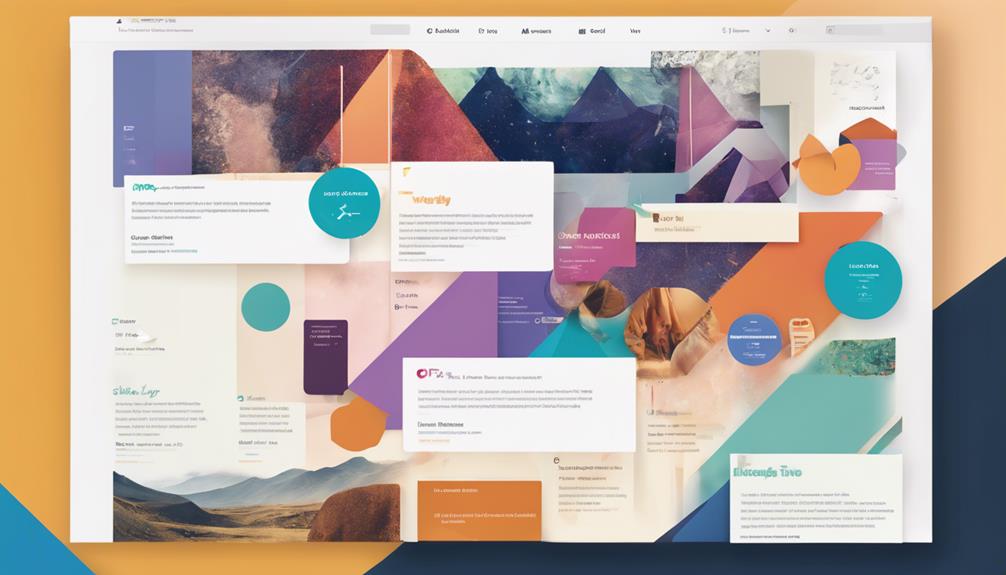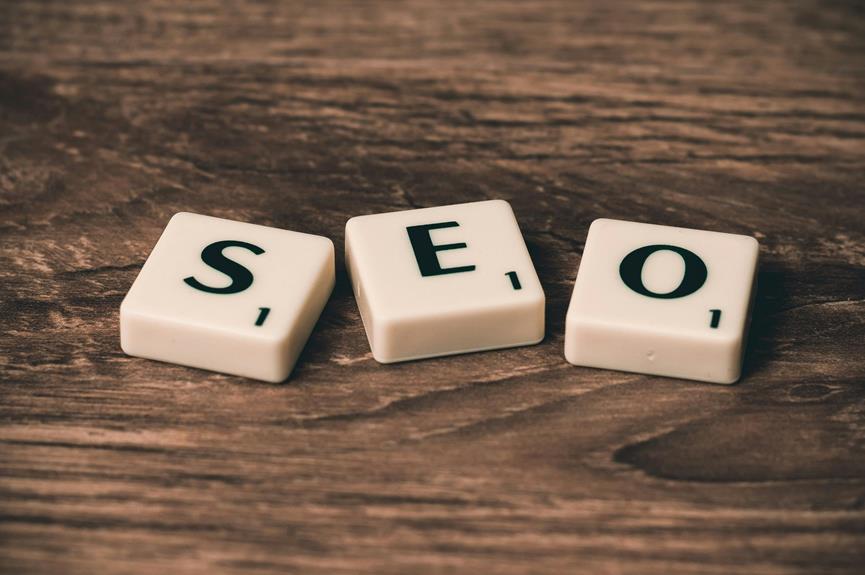If you're aiming to boost your website's search engine ranking, understanding on-page SEO is key. It starts with optimizing your title tags and crafting compelling meta descriptions that grab attention. Using header tags strategically not only clarifies your content's structure but also enhances keyword placement. Don't overlook internal linking, as it can significantly improve user navigation. Plus, a mobile-friendly site is non-negotiable in today's digital landscape. But that's just the beginning. There's more to explore, from page load speed to schema markup. Ready to uncover the rest?
Key Takeaways
- Optimize title tags and meta descriptions with concise, keyword-rich content to boost visibility and click-through rates.
- Use header tags strategically for clear content hierarchy and improved SEO through keyword placement.
- Enhance URL structure with concise, descriptive URLs including keywords for better relevance and clarity.
- Improve internal linking with descriptive anchor text to boost navigation, rankings, and accessibility.
- Ensure mobile-friendliness with responsive design, fast page load speed, and seamless navigation for enhanced user experience.
Optimize Title Tags
Optimizing title tags is a crucial strategy in enhancing your website's visibility and click-through rate. Title tags, the clickable headlines on search engine result pages, directly impact your site's ranking and user engagement. Data shows that over 60% of users click on the first three search results, so your goal should be to craft concise, keyword-rich titles that align with search intent.
To optimize, start by conducting thorough keyword research. Identify high-volume keywords relevant to your content and strategically incorporate them into your title tags. Remember, Google typically displays the first 50-60 characters of a title, so keep it brief yet descriptive.
Avoid keyword stuffing, which can lead to penalties and diminished user trust. Instead, strategically place primary keywords at the beginning of your title tag for maximum impact.
Analyze competitors' title tags using SEO tools to identify trends and gaps you can exploit. Data-driven adjustments, like including numbers or power words, can increase engagement significantly.
Regularly monitor your title tag performance through click-through rate data in Google Search Console, and tweak as necessary. By strategically optimizing title tags, you're setting a strong foundation for improved search visibility and user engagement.
Craft Compelling Meta Descriptions
Meta descriptions are your opportunity to entice users from search engine result pages to your website. Research shows that well-crafted meta descriptions can significantly increase click-through rates (CTR). To achieve this, focus on creating descriptions that are clear, engaging, and relevant to the user's search intent.
Keep in mind that Google often truncates descriptions longer than 155-160 characters, so it's crucial to convey your message succinctly. Use action-oriented language that compels users to click. Phrases like "Discover how," "Learn more," or "Find out" can drive curiosity and engagement.
Additionally, integrating target keywords naturally can enhance visibility, as search engines bold these terms when they match a user's query. However, avoid keyword stuffing, as it can harm readability and user experience.
Data from HubSpot indicates that personalized meta descriptions can improve CTR by up to 5.8%. Analyze your audience's needs and pain points, and tailor your descriptions accordingly.
Monitor performance regularly using tools like Google Search Console to understand which descriptions drive traffic and make adjustments as needed. By strategically crafting compelling meta descriptions, you can improve your site's ranking potential and attract more visitors.
Use Header Tags Strategically

When it comes to structuring your web content, effective use of header tags is key to both user experience and SEO performance. Header tags, ranging from H1 to H6, create a clear hierarchy, guiding readers and search engines through your content. Data shows that web pages with well-organized header structures rank higher because they enhance readability and signal content importance to search engines.
Start with an H1 tag for your main title, ensuring it's descriptive and keyword-rich. This not only helps search engines understand the primary topic but also grabs your reader's attention immediately.
Use H2 tags for major sections, breaking down your content into digestible parts. Further, employ H3 and beyond for sub-sections, providing a logical and accessible flow.
Strategically placing keywords within header tags can improve your SEO ranking. However, avoid keyword stuffing. Instead, focus on relevance and natural integration.
Data indicates that users spend more time on pages where they can easily scan and find the information they need. Thus, a clear header structure enhances user engagement, reducing bounce rates.
Improve URL Structure
Just as a well-structured header tag system enhances readability and SEO, a clean and logical URL structure can significantly impact your site's performance in search rankings. Optimizing your URLs isn't just about aesthetics; it's about clarity and relevance, which Google algorithms prioritize. Start by ensuring your URLs are concise and descriptive. They should give a clear indication of the page content, enabling both users and search engines to understand your site's architecture.
Here's a strategic breakdown:
| URL Best Practice | Impact |
|---|---|
| Use Hyphens | Improves readability |
| Keep It Short | Easier to remember & share |
| Include Keywords | Enhances relevance |
Avoid using unnecessary parameters or session IDs that add clutter and confusion to URLs. A clean structure doesn't only improve click-through rates but also facilitates easier indexation by search engines. Analyze your existing URLs and identify areas for improvement. Tools like Google Search Console can provide insights into how your URL structure affects site performance. Remember, a well-optimized URL structure serves as a roadmap, guiding search engines through your content efficiently. By strategically refining your URLs, you're not just enhancing SEO but also enriching user experience, ultimately driving better ranking outcomes.
Focus on Keyword Placement

Effective keyword placement is a cornerstone of successful on-page SEO strategy. To optimize your content, strategically position keywords where search engines and users naturally look.
Begin by incorporating primary keywords in the title tag, as it influences click-through rates and search rankings. Data shows that pages with keywords in their titles often rank higher.
Next, ensure your primary keyword appears within the first 100 words of your content. This placement signals relevance to search engines while immediately clarifying the topic for readers.
Remember, keyword frequency affects SEO, but avoid stuffing. Aim for a keyword density of 1-2%, based on industry standards, to maintain natural readability.
Headers (H1, H2, H3) are essential for structuring content and improving user experience. Use keywords in subheadings to enhance scannability and SEO, as they help search engines understand your page's hierarchy and context.
Don't overlook alt text for images; adding keywords here improves accessibility and search visibility.
Finally, consider keyword variations and synonyms throughout your text to capture broader search queries, increasing your page's chances of ranking for related terms.
Strategic keyword placement, done right, can drive organic traffic and improve search engine rankings.
Enhance Internal Linking
Elevate your on-page SEO strategy by enhancing your internal linking structure. Internal links, crucial for web navigation, can significantly impact how search engines perceive and rank your content. A well-crafted internal linking framework enhances user experience by guiding visitors through your site logically.
Research shows that pages with robust internal links rank higher, as search engines find them easier to crawl and index.
To strategically enhance your internal linking, consider the following data-driven points:
- Identify Key Pages: Focus on pages that drive conversions or have high engagement rates. Use tools like Google Analytics to pinpoint these pages and prioritize them in your linking strategy.
- Anchor Text Optimization: Use descriptive and relevant anchor text. A study found that clear anchor texts improve click-through rates by 20%. Ensure your anchor text naturally incorporates keywords for better SEO performance.
- Link Depth: Avoid burying important content deep in your website. Keep essential pages within three clicks from the homepage. This approach not only improves user experience but also ensures efficient crawling by search engines.
- Regular Audits: Conduct regular link audits to identify and fix broken or outdated links. This keeps your site healthy and ensures link equity flows effectively throughout your site.
Optimize Images and Alt Text

Optimizing images and alt text is a fundamental component of a robust on-page SEO strategy, with significant implications for both search engine visibility and user experience. When you optimize images, you're not just making your site visually appealing; you're enhancing its accessibility and searchability.
Start by compressing images to reduce file size without sacrificing quality. According to HTTP Archive, images make up 21% of an average webpage's weight, so efficient compression can be a game-changer.
Next, consider the importance of descriptive file names. Instead of generic titles like "IMG1234.jpg," use keywords that reflect the content, like "blue-widget-sale.jpg." This boosts relevance in search algorithms.
Alt text is equally crucial. It's not just for compliance with accessibility standards; it's a key element for SEO. Alt text provides context to search engines, helping them understand the image's content. Be strategic: use succinct, keyword-rich descriptions without keyword stuffing.
Increase Page Load Speed
Enhancing page load speed isn't just a technical tweak; it's a strategic move with measurable impacts on user engagement and SEO rankings. When pages load faster, users stay longer, bounce rates drop, and search engines reward you with higher visibility.
Research shows that a one-second delay can reduce conversions by 7%, so you can't afford to overlook this aspect of on-page SEO.
To strategically boost your page load speed, consider these data-driven actions:
- Optimize Your Code: Minify CSS, JavaScript, and HTML files to reduce their size. This decreases loading times without compromising functionality. Use tools like Google's PageSpeed Insights for tailored recommendations.
- Leverage Browser Caching: Store static resources on users' browsers. This means repeat visitors will enjoy faster load times since elements like logos and images won't need to be re-downloaded.
- Content Delivery Network (CDN): Utilize a CDN to distribute your site's data across multiple servers worldwide. This ensures users access your site from the nearest server, reducing latency.
- Image Compression: Compress images without losing quality. Large image files can significantly slow down your site, so use formats like JPEG 2000 or WebP for optimal performance.
Implementing these strategies will enhance user experience and improve your site's ranking potential.
Ensure Mobile-Friendliness

As mobile devices dominate web traffic, ensuring your site is mobile-friendly is no longer optional but a critical SEO strategy. Google's Mobile-First Indexing means your site's mobile version is prioritized for ranking. You need to analyze your site's responsiveness, navigation, and page structure. A strategic approach involves using responsive design, optimizing images, and simplifying navigation.
Here's a quick breakdown of factors affecting mobile-friendliness:
| Factor | Impact on SEO | Strategy to Improve |
|---|---|---|
| Responsive Design | High ranking boost | Use flexible grids |
| Page Speed | Affects bounce rate | Compress images |
| Touch Elements | User engagement | Ensure tappable areas |
| Navigation Simplicity | Reduces user frustration | Use clear menus |
| Content Readability | Content consumption | Use legible fonts |
Responsive design allows your content to adapt seamlessly across devices, enhancing user experience. Optimize touch elements by spacing them adequately, preventing accidental clicks. Simplify navigation to ensure users find what they need without hassle. Content must be readable; choose legible fonts and maintain a clean structure.
Keep in mind, Google's algorithm continuously adapts, so staying updated with mobile-friendly practices is essential. By strategically enhancing these factors, you'll boost engagement, decrease bounce rates, and improve your overall search ranking.
Implement Schema Markup
While ensuring your site is mobile-friendly is vital for SEO, another strategic layer to consider is implementing schema markup. Schema markup is a form of microdata that helps search engines understand your site's content better. By enhancing how your pages appear in search results, you can improve click-through rates and drive more traffic.
Here's why it's crucial:
- Improved Visibility: Sites using schema markup rank an average of four positions higher than those without. By providing context, it's easier for search engines to display rich snippets, which attract more clicks.
- Enhanced User Experience: Schema markup provides users with relevant information directly in search results, making it easier for them to find what they need. This can lead to higher engagement rates.
- Increased Click-Through Rates (CTR): Studies show a 30% increase in CTR for pages with schema markup. Rich snippets, like star ratings or event dates, make your listing stand out.
- Better Local SEO: For businesses with a physical presence, adding local schema markup can boost visibility in local search results, helping you reach more nearby customers.
Implementing schema markup strategically ensures your website's content is both accessible and appealing, ultimately driving better SEO performance.
Conclusion
By strategically implementing these on-page SEO techniques, you're setting up your website for success. Optimizing title tags and meta descriptions can significantly boost your visibility and click-through rates. Using header tags and improving URL structures enhances content clarity and keyword placement. Don't overlook the impact of fast-loading, mobile-friendly pages and optimized images with alt text. Finally, harness the power of schema markup to enhance search engine performance and user engagement, driving better rankings and traffic.


Leave a Reply